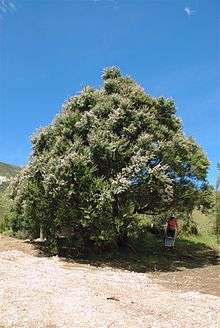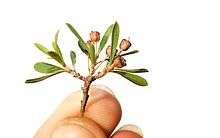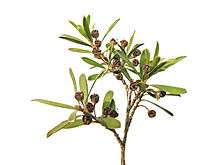Kunzea ericoides
| Kānuka | |
|---|---|
 | |
| Scientific classification | |
| Kingdom: | Plantae |
| (unranked): | Angiosperms |
| (unranked): | Eudicots |
| (unranked): | Rosids |
| Order: | Myrtales |
| Family: | Myrtaceae |
| Genus: | Kunzea |
| Species: | K. ericoides |
| Binomial name | |
| Kunzea ericoides (A.Rich.) Joy Thomps. | |
Kunzea ericoides (Kānuka, White tea-tree or Burgan)[1] is a tree or shrub that is restricted to Australia and New Zealand. Until 1983, Kānuka was classified as being in the genus Leptospermum.
Distribution and ecology
Kānuka (or mānuka, as it was mostly known until the 1930s) occurs in Australia and New Zealand. In Australia it occurs in South Australia, Victoria, New South Wales and Queensland, and these have been much confused in the recent past with the New Zealand species. As currently treated in New Zealand Kānuka is a recognised species complex with the type species (and variety) only known from the northern South Island.
Members of the kānuka complex are found throughout New Zealand occurring on the Three Kings Islands, Aotea (Great Barrier Island), from Te Paki (on the Aupouri Peninsula) at the northern tip of the North Island to as far south as Dunedin and Central Otago in the South Island, and Stewart Island. Within this range kānuka is widespread ranging from coastal scrub and sand dunes (where it may form a distinct forest type) through lowland and montane forest, with one member of the complex reaching elevations of 2000 metres above sea level. Kānuka often colonizes land recovering after a fire and is a critical part of the natural recovery of open disturbed ground to forest. With its small but abundant flowers it can colour a whole hillside white, almost giving the appearance of snow cover. It is widespread particularly in coastal scrub and colonizing land recovering after a fire or reverting to a natural state after being used for agriculture. It has also been recorded growing to altitudes of 2000 metres above sea level. The wood is very hard and although not durable in the ground it is used for wharf piles and tool handles. It is particularly popular as firewood, and burns with a great heat.
In New Zealand, kānuka can grow to around 10 metres high. Kākāriki parakeets (Cyanoramphus) use the leaves and bark of kānuka and the related mānuka tea trees to rid themselves of parasites. Apart from ingesting the material, they also chew it, mix it with preen gland oil and apply it to their feathers.[2] Mānuka and kānuka are superficially similar species and are often confused with one another. The easiest way to tell the difference between them is to feel the foliage, kānuka leaves being soft, while mānuka leaves are prickly.[3] K. ericoides may occur in the understory of certain rimu/nothofagus forests in the South Island. Typical associate understory species may include Crown Fern, Blechnum discolor and Cyathodes fasciculata.[4]
 Showing foliage and seedpods. Pinched between fingers for scale
Showing foliage and seedpods. Pinched between fingers for scale
 Young plant
Young plant
Prostrate kānuka
A variety of kānuka, the prostrate kānuka (Kunzea ericoides var. microflora), is one of the few plants that can survive hot ground in the immediate surroundings of geothermal features such as fumaroles and craters, for instance at "Craters of the Moon" (Karapiti), a geothermal area close to Taupo, New Zealand.[5]
See also
References
- John Dawson and Rob Lucas. 2000. Nature guide to the New Zealand forest, Godwit Publishing
- David R. Given. 1980. Vegetation on heated soils at Karapiti, central North Island, New Zealand, and its relation to ground temperature in New Zealand Journal of Botany, vol. 18: 1-13
- C. Michael Hogan. 2009. Crown Fern: Blechnum discolor, Globaltwitcher.com, ed. N. Stromberg
- PlantNET: New South Wales Flora Online: Kunzea ericoides
| Wikimedia Commons has media related to Kunzea ericoides. |
Footnotes
- ↑ Kānuka is a Māori-language word borrowed into New Zealand English. Other Māori language names include mānuka, mānuka-rauriki (lit, 'small-leaved mānuka), māru, mānuoea and rāwiri.
- ↑ Terry Greene. 1989. Antiparasitic behaviour in New Zealand parakeets ("Cyanoramphus" species). Notornis (journal)| 36(4): 322–323. PDF fulltext
- ↑ John Dawson and Rob Lucas. 2000
- ↑ C. Michael Hogan. 2009
- ↑ David R. Given. 1980